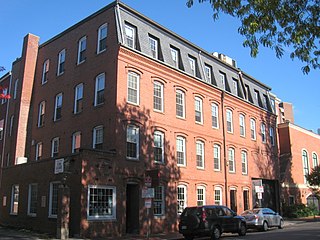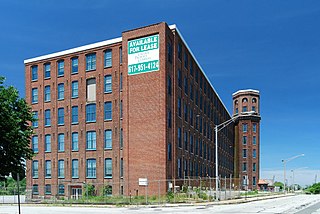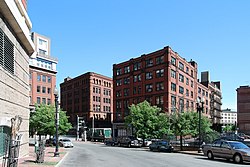
Biddeford is a city in York County, Maine, United States. It is the principal commercial center of York County. Its population was 22,552 at the 2020 census. The twin cities of Saco and Biddeford include the resort communities of Biddeford Pool and Fortunes Rocks. The town is the site of the University of New England and the annual La Kermesse Franco-Americaine Festival. First visited by Europeans in 1616, it is the site of one of the earliest European settlements in the United States. It is home to Saint Joseph's Church, the tallest building in Maine.

Harvard Square is a triangular plaza at the intersection of Massachusetts Avenue, Brattle Street and John F. Kennedy Street near the center of Cambridge, Massachusetts, United States. The term "Harvard Square" is also used to delineate the business district and Harvard University surrounding that intersection, which is the historic center of Cambridge. Adjacent to Harvard Yard, the historic heart of Harvard University, the Square functions as a commercial center for Harvard students, as well as residents of western Cambridge, the western and northern neighborhoods and the inner suburbs of Boston. The Square is served by Harvard station, a major MBTA Red Line subway and a bus transportation hub.

Central Square is an area in Cambridge, Massachusetts centered on the junction of Massachusetts Avenue, Prospect Street and Western Avenue. Lafayette Square, formed by the junction of Massachusetts Avenue, Columbia Street, Sidney Street and Main Street, is also considered a part of the Central Square area. Harvard Square is to the northwest along Massachusetts Avenue, Inman Square is to the north along Prospect Street and Kendall Square is to the east along Main Street. The section of Central Square along Massachusetts Avenue between Clinton Street and Main Street is designated the Central Square Historic District, and was added to the National Register of Historic Places in 1990.

Wakefield is a village in the town of South Kingstown, Rhode Island, United States, and the commercial center of South Kingstown. Together with the village of Peace Dale, it is treated by the U.S. Census as a component of the census-designated place identified as Wakefield-Peacedale, Rhode Island. West Kingston, another South Kingstown village, was the traditional county seat of Washington County. Since 1991, the Washington County Courthouse has been in Wakefield. The Sheriff's Office which handles corrections is also in Wakefield.

Mount Vernon Square is a city square and neighborhood in the Northwest quadrant of Washington, D.C. The square is located where the following streets would otherwise intersect: Massachusetts Avenue NW, New York Avenue NW, K Street NW, and 8th Street NW.

The Leather District is a neighborhood of Boston near South Street, between the Financial District and Chinatown. The Leather District is a tightly defined area bounded by Kneeland Street to the south, Essex Street to the north, Atlantic Avenue to the east and Lincoln Street to the west. It is so named due to the dominance of the leather industry in the late 19th century.

The Reversible Collar Company Building is a historic factory building at 25–27 Mt. Auburn & 10–14 Arrow Streets in Cambridge, Massachusetts. The building has a complex construction history, consisting of several buildings constructed separately between 1862 and 1907, and gradually combined into a single structure. The oldest portions were built by Allen and Farnham, a printing business. The property was sold to the Reversible Collar Company in 1867, which expanded the facility. The company at first manufactured paper shirt collars, but later also produced paper and paper-fabric combinations for use in products like wall charts and maps. The buildings on the site were sold to the Boston Bookbinding Company in 1897. In the late-1960s the building was converted to office and commercial space.

Stafford Mills is an historic textile mill complex located on County Street in Fall River, Massachusetts, USA. Founded in 1872, it is a well-preserved late-19th century textile complex, typical of the mills built in Fall River during its period of most rapid growth. It is noted in particular for its exceptionally fine Romanesque brick office building. The complex was added to the National Register of Historic Places in 1983.

The Central New Bedford Historic District is one of nine historic districts in New Bedford, Massachusetts, United States. The district encompasses the city's central business district, built up during the time in the late 19th century when textiles had replaced whaling as the city's main industry. It is a 29-acre (12 ha) rectangular area bounded by Acushnet Avenue and the older New Bedford Historic District on the east, School Street to the south, Middle Street on the north and 6th Street in the west. It was added to the National Register of Historic Places in 1980.

Mechanics Mill is an historic cotton textile mill located at 1082 Davol Street in Fall River, Massachusetts.

Pilgrim Mills is an historic textile mill located at 847 Pleasant Street in Fall River, Massachusetts. The mill was built in 1911 from red brick and was the first mill in the city powered entirely by electricity, provided from the local grid. It was one of the last mill complexes built in the city. The property was listed on the National Register of Historic Places in 1983.

The Monument Square–Eagle Street Historic District is a historic district encompassing the civic heart of North Adams, Massachusetts. When it was originally designated in 1972, the district encompassed Monument Square – west of the intersection of Main Street and Church Street, and the location of a Civil War memorial – and the area around it. This designation included the North Adams Public Library, the First Baptist Church and First Congregational Church, and a block of shops Eagle Street. In 1988, the district's boundaries were increased to be roughly bounded by Holden, Center and Union Streets, the East Middle School, Summer Street, and Main Street. This expansion extended the district westward along Summer Street to include the US Post Office building and St. John's Church, and eastward to include Colgrove Park, the middle school, and St. Francis Catholic Church. An additional block of commercial buildings was also added on the north side of West Main Street, extending just west of Holden Street.

Monument Mills are historic textile mills at Park and Front Streets in the Housatonic village of Great Barrington, Massachusetts. Developed beginning in the mid-19th century, they were a major American producer of jacquard fabrics, operating until 1955. The mill complexes were listed on the National Register of Historic Places in 1983. Today, some parts of the complex houses artists and small businesses.

Windsor Print Works is a historic textile mill at 121 Union Street in North Adams, Massachusetts. Founded in 1829, with buildings dating to 1872, it was one of the first textile mills in western Massachusetts, and the first place in the United States to create printed cotton fabric. It was listed on the National Register of Historic Places in 1973. The property now houses a variety of arts-related and light manufacturing businesses.

The Central Square Historic District is a historic district encompassing the central town common of the city of Waltham, Massachusetts, and several commercial buildings facing the common or in its immediate vicinity. The common is bounded by Carter, Moody, Main, and Elm Streets; the district includes fourteen buildings, which are located on Main, Elm, Lexington, and Church Streets, on the north and east side of the common. The district was listed on the National Register of Historic Places in 1989.

The Central Square Historic District is a historic district encompassing much of the central business district of Stoneham, Massachusetts. It includes the town's largest concentration of 19th and early-20th century commercial architecture, in an area that developed in importance as a commercial center after the construction of the Andover-Medford Turnpike. The district was added to the National Register of Historic Places in 1990.

The Piety Corner Historic District encompasses one of the oldest settled areas of Waltham, Massachusetts. It is centered on a major road intersection, the junction of Totten Pond Road with Lexington and Bacon Streets, and includes the city's largest single concentration of well-preserved 19th and early 20th-century houses. It extends south from Totten Pond Road along Bacon Street as far as Greenwood Lane, and along Lexington Street to Beaver Street. The district was listed on the National Register of Historic Places in 1990.

The Lawton Place Historic District is a historic district on Lawton Place between Amory Road and Jackson Street in Waltham, Massachusetts. The district preserves some of the nation's oldest textile mill worker housing. The duplex houses located on the south side of Lawton Place were built c. 1815-17 by the Boston Manufacturing Company (BMC), the first mill to process textiles entirely under one roof. They were originally located at what is now the Waltham Common, and were moved to Lawton Place in 1889. On the north side stands a rowhouse that was built in 1889; it is the last instance of a type of row housing that was once commonly built for mill workers. The district was listed on the National Register of Historic Places in 1989.

The Carroll Building in Norwich, Connecticut, also known as the Flat Iron Building, was built in 1887. It was listed on the National Register of Historic Places (NRHP) in 1982. It is included in the Downtown Norwich Historic District, which is also listed on the NRHP. Originally used as offices and retail stores, the building is now currently used primarily as an apartment building. The Carroll Building is located on a triangular tract created by the intersection of Main and Water Streets. The building is highly visible from Washington Square and is one of the most noticeable aspects of the downtown streetscape. The building is currently vacant.

The Jaffrey Mills is a historic mill complex at 41 Main Street, in the central business district of Jaffrey, New Hampshire. It consists of a connected series of primarily brick buildings flanking the Contoocook River just north of Main Street. Its oldest buildings, the original mill and office building, are on the west side of the river. They were built in 1868, and feature mansard roofs and banded dentil brick cornices. The mill building has a tower that originally sported a cupola, but this was removed early in the 20th century. In 1872 the building on the east side was built, and the two sides joined by timber-frame bridges were added in 1897, at the same time the east building was extended northward. Later additions to the north of the east building include a storage area and a loading dock. The mill complex, the only 19th-century industrial complex of its type to be built in Jaffrey, was listed on the National Register of Historic Places in 1982. It has been converted into residences.
























